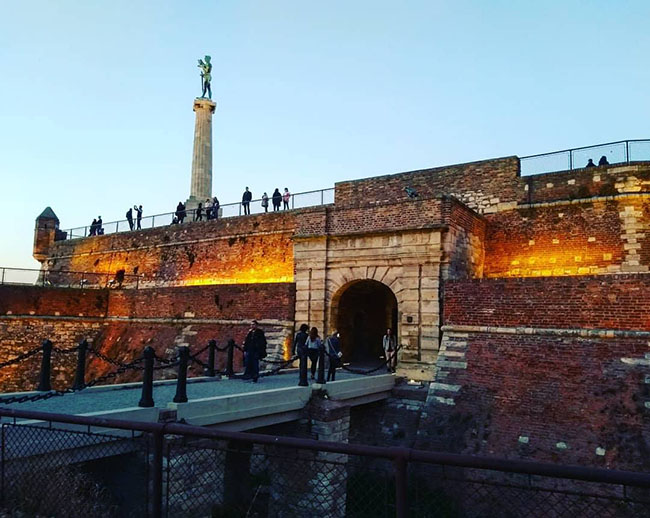Statement of SASA Department of Historical Sciences
Three decades ago, the Department of Historical Sciences published proceedings of the scientific gathering, at which twenty of our most distinguished experts in various fields focused on the Belgrade Fortress. New discoveries based on carefully conducted archaeological research and thorough studies of various resources, painted a new picture of the Fortress and its 2000 year long history, but they also urged the general public to devote itself to the vision of its future reasonably expected by one of the organizers, Board for the Third Millennium. Not only did it encompass the issue of direct organization of the complex and possibilities of reconstruction of certain parts based on current research, but also the position of the Fortress in the urban city development design. All addresses were rife with care to protect and preserve its values, with rational critical remarks that the objectives of the Fortress being organized as a cultural-historical monument had not been uniformly fulfilled. The obligation of conducting all archaeological research in accordance with the Project of the Belgrade Fortress was emphasized in the first place, and afterwards, the propositions of conservation and restoration of specific parts based on evaluation were presented.
The Future of Belgrade Fortress, which at that time was object of special attention, today is the Present when we have to rise to the challenge which is in contrast with not just the duties we accepted but also with basic principles of valuating and caring for cultural heritage clearly defined in all legal documents.
The matter in question is the construction of cable car between the core of the Belgrade Fortress and the other bank of the Sava River with shopping centre in the middle, which would violate the unique monument ensemble and the idea of Fortress’s position at the confluence of two great rivers not existent in any medieval town. Its character and significance at the intersection of waterways and land roads, between large states and distinct civilizations, have been confirmed over the centuries by travel writers and conquerors one way or another, who would, impressed by its looks or devoted to the Fortress characteristics to be conquered, draw graphics of shapes and unique contours of the city over the waters, where ships sailed in peace times connecting economies of distant countries. The fact that the project of unfortunate tourist attraction construction has been approved by the Republic Institute for the Protection of Cultural Monuments of Serbia which was entrusted with the care of the Fortress for its special significance, is particularly devastating.
In this press release, it is not necessary to remind the general public of the long history of our city since the times when Singidunum together with IV Flavia Felix defended the northern border of the Roman Empire, and then for the centuries was a witness and a scene of battles, testified to the rule of the Huns, Avars, Hungary, Byzantine Empire and others, flourished as the capital of Despot Stefan Lazarević and was repeatedly ravaged and fortified until the First Serbian Uprising for its strategic position and significance in the wars of Hungary, Turkey and Austria. The layers of all these historical periods can be found in the Fortress. Several century long remains of the past have been directly endangered by the recently presented project of the City of Belgrade for the construction of the cable car. This decision brought about multiple reactions of professional associations concerning the sensibility and legal foundation of the project, such as the Archaeological Society, the Society of Conservators of Serbia, the Academy of Architecture of Serbia, the Museum Society of Serbia, ICOM National Committee Serbia, Department of Archaeology of the Faculty of Philosophy of the University of Belgrade, ICOMOS National Committee and a great number of renowned experts in architecture, urbanism, university professors, tourist experts, ecologists and others, including a majority of experts of the Republic Institute for the Protection of Cultural Monuments of Serbia, who contested the decision validity and asked for suspension of cable car construction.
The Department of Historical Sciences of the Serbian Academy of Sciences and Arts, being multiply involved in the study of the past and cultural heritage of Belgrade, which was demonstrated by the aforementioned gathering about the Fortress, calls upon itself to express its opposition to the intention of violating its unique ensemble and endangering remains of the past. In its vision of the future, the Department of Historical Sciences, has expected, as before, to enrich the historical landscape of the Fortress as well as the settlements around it by comprehensive studies. The construction of the so-called cable car, which ruins the familiar city skyline, is unexpected blow to the efforts of keeping the Fortress and Kalemegdan inseparable main part of urban ensemble encompassing the University with numerous faculties, museums, galleries, concert halls, libraries and other cultural institutions.
P.S.
Personas who, after all, persist in their intention to damage the appearance and dignity of the city which, as it has been archaeologically confirmed, at Despot Stefan’s times was at the highest, should read, if they have strength, exciting pages penned by his biographer Constantine the Philosopher with detailed description of the fortified capital and its residents all of whom had stamped form of their city on the documents protecting them as its citizens. As for the question of approach to the Fortress, one should remember the dilemma of Greek experts who at the time of the World Congress of Architects in Athens, considered the possibility of replacing century old approach to the Acropolis by climbing stone boulders, with carved stairs, a ramp…or even a furnicular. Le Corbusier, a modern architecture protagonist, answered this question with: Gentlemen, on your knees.

